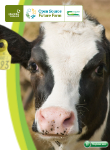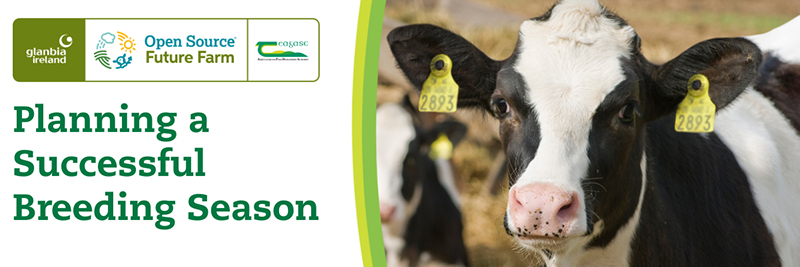
Breeding Webinar with Francis Nolan
Type Event Proceeding
Planning a Successful Breeding Season with Teagasc/Glanbia Future Farmer Francis Nolan

On Thursday, 25 March a Breeding Webinar took place with Teagasc/Glanbia Future Farmer Francis Nolan, Co. Kilkenny. Francis was joined by Richie O’Brien, Teagasc; George Ramsbottom, Teagasc and Joris Somers, Glanbia to discuss the steps Francis is taking to plan for a successful breeding season on his farm this year.
Topics discussed included: Management; Genetics; Nutrition and Disease.
You can watch it back here or read more about Francis Nolan’s farm below:
Read more about Francis’s farm below
Farming at 700-900 ft above sea level is a challenge! But Francis Nolan from Co. Kilkenny is demonstrating what can be achieved in these conditions, milking 140 cows & aiming to produce 550 kg milk solids/cow by 2025.
Francis was originally a suckler beef farmer before making the transition to dairying in 2013. He is a participant of the Teagasc/Glanbia Future Farm Programme since autumn 2019 with an aim to achieve high profit while reducing his carbon footprint. The aim is to grow 15 tonnes grass DM/ha to sustain a stocking rate of 2.5 LU/ha & to continuously improve herd genetics. But what does this mean in practice & what changes are taking place on Francis’s farm?
Overall farm stocking rate 207 kg organic N/ha (2.5 LU/ha on grass area) – farm in Nitrates derogation
Francis Nolans Herd Performance 2020
- 491 kg Milk Solids supplied – 4.38% fat & 3.67% protein. Additional 28 kg MS fed to calves
- 6 week calving rate 84% & 373 day calving interval
- After 12 week breeding season herd infertility was 6%
Breeding
Herd EBI in 2020 was €139 with the calves born in that year having an EBI of €182 demonstrating ongoing genetic improvement (2016 Herd EBI was €72). The overall EBI figure can be broken down into the Milk sub-index & fertility sub-index with 2020 born animals in brackets. The maintenance, beef & health sub-indexes are also closely monitored.
| Herd (2020 calves) | Target | |
|---|---|---|
| Milk sub-index | €33 (€58) | €80 |
| Fertility sub-index | €72 (€79) | €100 |
| Maintenance sub-index | €16 (€15) | €14 (570 kg mature cow) |
| Beef sub-index | €-12 (€-15) | €-12 |
| Health sub-index | €3 (€3) | €5 |
Cows were weighed in July 2020 & had a mature weight of 587kg which corresponds with a maintenance figure of €16 & the aim is to have a mature cow weight of 570 kg (maintenance €14).
In this clip, Francis discusses breeding management on his farm
At present, Francis is able to sell his beef calves off the farm & aims to continue to do this (maintain beef sub-index at current levels). Sires are selected to match these criteria. Mainly genomic sires are selected using a team of 10 bulls with an average EBI of greater than €250, a milk sub-index of at least €80 & a fertility sub-index of at least €100. The bull team will also have an average of +24kg fat & protein.
Francis uses the Sire Advice programme on ICBF Herd Plus to match sire & dam and to avoid inbreeding.
- Used sexed semen on heifers in 2020 – conception rate at 50% was disappointing but going to try it again in 2021 Has the advantage of ensuring that replacement heifers are born early
- Pre breeding intervention to detect problem cases
- 6 weeks FR AI – DIY. 230 Fr straws to deliver 50 heifer calves(includes sexed semen)
- Heat detection – collars + automatic drafting. 2021 – first year using this
- Late calvers & first calvers put on OAD 4 weeks pre breeding
- Vaccination – Lepto, Salmonella, IBR (not vaccinating for BVD)
- Successful heifer rearing – 300kg+ spring turnout 2021
- Scanning end breeding season
Francis Nolan discusses bull selection on his farm
Herd Nutrition
The backbone to the system is grazed grass. Francis uses the Teagasc Pasturebase system to measure grass growth. Monday is the day designated for measuring grass with results uploaded on to Pasturebase App as he is walking the farm. In 2020 the farm grew 12.5 tonnes DM/ha but he needs to grow 14-15 T DM/ha to feed the herd without buying in silage. In order to increase production steps are being taken to improve soil fertility combined with a re-seeding programme.
Some of the key aspects of this are as follows:
- 38% farm index 1 & 2 for Phosphate (P) & 30% farm at index 1 & 2 for Potash (K) – using fertilizer such as 18-6-12 on fields in need of it. Slurry targeted at silage fields & low index fields. Has a derogation allowance of 1400 kg P – works within this
- Lime requirement of 178 tonnes – will be applied over 3-4 years
- Buying in some silage at present – as more grass is grown this will cease
- Re-seeding programme. Has used all tetraploid mixes on dry parts of the farm to facilitate better clean-outs. No issues with poaching resulting from more open swards
- Paddocks set up for 2-3 grazings/paddock & pre grazing yield of 1400 kg DM/Ha. Surplus grass harvested as baled silage. In 2020 this resulted in 150 bales high quality silage for milking cows (1 bale/cow)
- Early turn-out using on/off grazing system – mid February. Aims to complete first rotation by mid April. Closes off paddocks from early October to allow grass build-up
- One round topping in 2020
- High quality silage – 78% DMD first cut 2020
- Slurry spreading – use of Low emission umbilical system. Has applied for TAMS grant for tanker & trailing shoe
- Nitrogen usage – 190 kg/ha(150 units/acre). Uses Protected urea – happy with results, cheaper than CAN. Also uses about 20 units Sulphur on grazing ground during the year
- Meal usage – 1 tonne in 2020. Aims to reduce this to 750 kg in the future
In this clip, Francis Nolan discusses grassland management on his farm
Sustainability & Bio-diversity
- Tree planting in strategic locations
- Watercourses fenced
- Roadways beside watercourses re-located with added benefit of improved cow flow
- Solar panels installed on parlour roof through FarmGen(Glanbia) – saving of €100/month
- Farm biodiversity
- Variable speed milk pump – reduced energy use
- Biodiversity level on farm – 9% (hedgerows, watercourses, field margins). Target 10%
Labour saving
- Automatic calf feeder in use 2021 – middle of working day used to check calves
- Collars on cows & automatic drafting – no stock bulls
- New cubicle shed & tank built 2020 with robotic slurry scraper
- Contractor hired to spread slurry with umbilical system
- Additional labour on farm – local farmer with flexible hours
- Farm records – uses technology as much as possible e.g. Agrinet Herd App. Assistance from Francis’ wife Ann with paperwork
Summary
The aim of this farm is to grow plenty of grass & convert it into milk solids in a sustainable manner. Maintaining farm biodiversity is a key component of this as is using energy efficiently & employing labour saving practices. Profitable farming & sustainable faming can go hand in hand.
